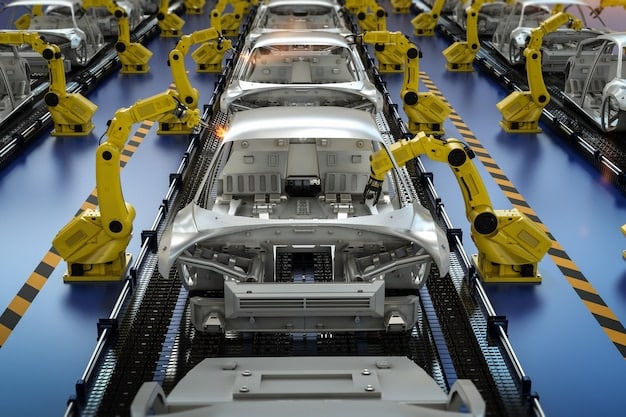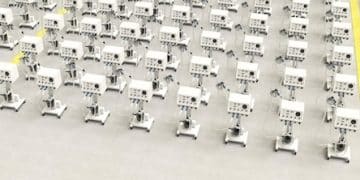Chip Shortage Easing: Projected Effects on US Auto Production

The easing of the chip shortage is projected to have a positive effect on US auto production in the next six months, leading to increased manufacturing, potentially lower vehicle prices, and a wider availability of new cars and trucks for consumers.
What are the projected effects of the chip shortage easing on US auto production in the next 6 months? As the global chip shortage shows signs of easing, the US auto industry is poised for a potential rebound. Let’s explore the anticipated impacts on production, availability, and pricing of vehicles.
Understanding the Chip Shortage and Its Impact
The global chip shortage has severely impacted various industries, and the automotive sector has been among the hardest hit. This shortage has led to significant production cuts, affecting vehicle inventories and prices. Understanding the root causes and the extent of the chip shortage is crucial for assessing its future impact.
Root Causes of the Chip Shortage
The chip shortage was triggered by several factors, including increased demand for electronic devices during the COVID-19 pandemic, supply chain disruptions, and geopolitical tensions. Here’s a closer look:
- Increased Demand: The pandemic led to a surge in demand for personal computers, gaming consoles, and other electronic devices, straining chip production capacity.
- Supply Chain Disruptions: Lockdowns and other pandemic-related disruptions caused delays and shutdowns in chip manufacturing plants.
- Geopolitical Tensions: Trade disputes and political instability in regions with major chip manufacturing facilities added to the uncertainty.
Effects on US Auto Production
The chip shortage has forced US auto manufacturers to reduce production, leading to lower inventory levels at dealerships. This has, in turn, driven up prices and limited consumer choices.

The easing of the chip shortage promises a return to normalcy, potentially boosting production and easing consumer concerns.
In summary, the chip shortage’s impact on US auto production has been significant, but with signs of easing, there’s potential for recovery and growth in the coming months.
Projected Increase in Vehicle Manufacturing
With the chip supply expected to increase, US auto manufacturers are planning to ramp up vehicle production. This increase in output could help to replenish depleted inventories and meet pent-up consumer demand. The projected rise in vehicle manufacturing is a critical step towards restoring balance in the auto market.
Production Targets for the Next Six Months
Several major automakers have announced ambitious production targets for the next six months, contingent on stable chip supplies. These targets include:
- General Motors: Aiming to increase production by 20% compared to the previous six-month period.
- Ford: Planning a 25% increase in output, focusing on popular models like the F-150 and Explorer.
- Stellantis: Targeting a 15% increase in production across its various brands.
Impact on Inventory Levels
An increase in vehicle manufacturing will directly translate to higher inventory levels at dealerships. This means consumers will have more choices and shorter wait times when purchasing new vehicles.
Improved inventory levels are also expected to reduce the pressure on prices, potentially leading to more competitive deals for buyers. As manufacturers meet their production targets, the availability of models and trims should also improve, catering to a broader range of consumer preferences.
Overall, the projected increase in vehicle manufacturing spells positive news for both automakers and consumers, setting the stage for a more robust and balanced auto market.
Potential Decrease in Vehicle Prices
One of the most anticipated effects of the chip shortage easing is the potential for lower vehicle prices. Throughout the shortage, prices for both new and used cars have surged due to limited supply. As production increases, these prices are expected to moderate.
Factors Influencing Price Reductions
Several factors will contribute to the potential decrease in vehicle prices:
- Increased Supply: As more vehicles are manufactured and shipped to dealerships, the laws of supply and demand should bring prices down.
- Reduced Demand: Some consumers who were willing to pay high prices during the shortage may hold off on purchases as prices begin to normalize.
- Incentives and Discounts: Automakers may reintroduce incentives and discounts to attract buyers as inventory levels improve.
Expert Opinions on Price Trends
Industry analysts predict a gradual decline in vehicle prices over the next six months. While prices may not return to pre-shortage levels immediately, the trend is expected to be downward.

The easing of the chip shortage promises a more competitive and affordable market for auto buyers, offering relief from the inflated prices seen in recent times.
Wider Availability of New Car Models
The chip shortage has not only driven up prices but has also limited the availability of certain car models and configurations. With the easing of the shortage, consumers can expect to see a wider range of choices at dealerships. This increased availability will cater to diverse consumer preferences and needs, leading to a more satisfying buying experience.
Specific Models Expected to Become More Available
Several popular models that were severely affected by the chip shortage are expected to become more readily available. These include:
- SUVs: Models like the Ford Explorer, Chevrolet Tahoe, and Jeep Grand Cherokee, which have been in high demand but short supply.
- Trucks: The Ford F-150, Ram 1500, and Chevrolet Silverado, which are critical for both personal and commercial use.
- Electric Vehicles: Models like the Tesla Model 3, Ford Mustang Mach-E, and Chevrolet Bolt, which have seen growing interest but limited availability.
Consumer Benefits of Increased Model Options
The wider availability of new car models offers several benefits to consumers:
Improved selection allows buyers to find vehicles that precisely match their needs and preferences, whether it’s a specific trim level, color, or feature package. Reduced wait times mean consumers can get behind the wheel of their desired vehicle much sooner, avoiding lengthy delays. More options also foster greater competition among manufacturers and dealerships, potentially leading to better deals and incentives.
In essence, the increased availability of new car models will empower American consumers with more choices, convenience, and value in their vehicle purchases.
Impact on Employment in the Auto Industry
The easing of the chip shortage is projected to have a positive impact on employment within the US auto industry. Increased production demands will necessitate more workers on assembly lines, in component manufacturing, and in related support services. This boost in employment can contribute to economic growth and stability in regions heavily reliant on automotive manufacturing.
Job Creation Opportunities
Here’s a look at the potential job creation opportunities:
- Manufacturing Plants: As production ramps up, automakers will need to hire more assembly line workers, technicians, and quality control specialists.
- Component Suppliers: Companies that supply parts and components to automakers will also need to increase their workforce to meet higher demand.
- Dealerships: With increased inventory, dealerships will need more sales staff, service technicians, and administrative personnel.
Regional Economic Benefits
The positive impact on employment will be particularly felt in regions with significant automotive manufacturing presence, such as Michigan, Ohio, Indiana, and Tennessee. Increased employment leads to higher incomes, increased consumer spending, and overall economic growth in these areas.
The auto industry is a critical driver of the US economy, and a rebound in production and employment can have a ripple effect, benefiting numerous related sectors and communities. The easing of the chip shortage not only promises to revitalize the auto industry, but to provide a substantial lift to employment and economic prosperity nationwide.
Long-Term Implications for the US Auto Market
The easing of the chip shortage is not just a short-term relief but has long-term implications for the US auto market. It could reshape manufacturing strategies, supply chain resilience, and technological investments within the industry. By analyzing these long-term impacts, stakeholders can better prepare for future challenges and opportunities in the automotive sector.
Changes in Manufacturing Strategies
The chip shortage has prompted automakers to rethink their manufacturing strategies. Some potential changes include:
- Diversifying Chip Suppliers: Automakers may seek to reduce their reliance on a single source for chips by diversifying their supplier base.
- Building Strategic Reserves: Companies may stockpile critical components to buffer against future supply disruptions.
- Investing in Domestic Chip Production: There may be increased investment in domestic chip manufacturing to reduce dependence on foreign suppliers.
Supply Chain Resilience
The crisis has underscored the importance of supply chain resilience. Automakers are likely to invest in measures to strengthen their supply chains, such as:
Establishing better communication and coordination with suppliers. Implementing advanced tracking and monitoring systems to detect potential disruptions early. Developing contingency plans to mitigate the impact of future shortages or disruptions.
These adjustments can lead to a more robust and competitive US auto market in the years to come.
“`html
| Key Point | Brief Description |
|---|---|
| 🚗 Increased Production | Manufacturers aim to boost output to replenish depleted inventories. |
| 💰 Potential Price Drop | Prices for new and used vehicles may decrease due to higher supply. |
| 🏢 Job Opportunities | More jobs in manufacturing, component supply, and dealerships. |
| 📈 Wider Model Availability | A broader range of car models and configurations will be available. |
“`
Frequently Asked Questions
▼
No, price reductions are expected to be gradual. It will take time for increased production to fully replenish inventories and for market dynamics to normalize.
▼
Popular SUVs and trucks, such as the Ford Explorer, Chevrolet Tahoe, Ford F-150, and Ram 1500, are likely to be among the first to see increased availability.
▼
Increased chip supplies will allow manufacturers to ramp up production of electric vehicles, potentially leading to more models and shorter wait times for consumers.
▼
Automakers are diversifying their chip suppliers, building strategic reserves, and investing in domestic chip production to reduce their vulnerability to supply disruptions.
▼
Yes, an increase in auto production is expected to create job opportunities in manufacturing plants, component supply companies, and dealerships across the country.
Conclusion
In conclusion, the easing of the chip shortage is poised to bring about positive changes in the US auto market over the next six months. Increased vehicle manufacturing, potential price reductions, a wider range of available models, and new employment opportunities are just some of the anticipated effects. While challenges may still exist, the overall outlook is optimistic, promising a more balanced and consumer-friendly automotive landscape.





